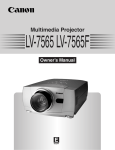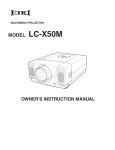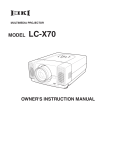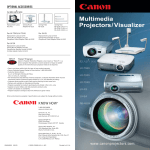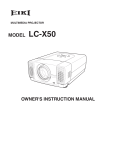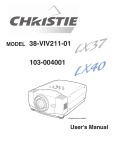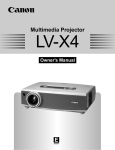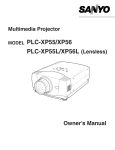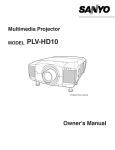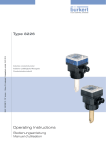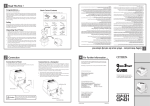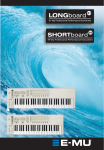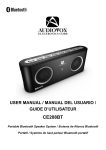Download Canon LV-7565 Owner`s manual
Transcript
Multimedia Projector
LV-7565 LV-7565F
Owner’s Manual
E
English
Downloaded From projector-manual.com Canon Manuals
TO THE OWNER
Before operating this projector, read this manual thoroughly
and operate the projector properly.
This projector provides many convenient features and
functions. Operating the projector properly enables you to
manage those features and maintains it in better condition for
a considerable time.
Improper operation may result in not only shortening the
product-life, but also malfunctions, fire hazard, or other
accidents.
If your projector seems to operate improperly, read this
manual again, check operations and cable connections and try
the solutions in the “Troubleshooting” section in the end of this
booklet. If the problem still persists, contact the dealer where
you purchased the projector or the service center.
CAUTION
RISK OF ELECTRIC SHOCK
DO NOT OPEN
CAUTION :
TO REDUCE THE RISK OF ELECTRIC
SHOCK, DO NOT REMOVE COVER (OR
BACK). NO USER-SERVICEABLE PARTS
INSIDE EXCEPT LAMP REPLACEMENT.
REFER SERVICING TO QUALIFIED
SERVICE PERSONNEL.
THIS SYMBOL INDICATES THAT DANGEROUS
VOLTAGE CONSTITUTING A RISK OF ELECTRIC
SHOCK IS PRESENT WITHIN THIS UNIT.
THIS SYMBOL INDICATES THAT THERE ARE
IMPORTANT OPERATING AND MAINTENANCE
INSTRUCTIONS IN THE OWNER'S MANUAL WITH
THIS UNIT.
CAUTION
Not for use in a computer room as defined in the Standard for
the Protection of Electronic Computer/Data Processing
Equipment, ANSI/NFPA 75.
Ne puet être utillisé dans une salle d’ordinateurs telle que
définie dans la norme ANSI/NFPA 75 Standard for Protection
of Electronic Computer/Data Processing Equipment
Safety Precaution
WARNING : TO REDUCE THE RISK OF FIRE OR ELECTRIC
SHOCK, DO NOT EXPOSE THIS APPLIANCE
TO RAIN OR MOISTURE.
– This projector produces intense light from the projection
lens. Do not stare directly into the lens as possible. Eye
damage could result. Be especially careful that children do
not stare directly into the beam.
– Install the projector in a proper position. If not, it may result
in a fire hazard.
– Provide appropriate space on the top, sides and rear of the
projector cabinet for allowing air circulation and cooling the
projector. Minimum clearance must be maintained. If the
projector is to be built into a compartment or similarly
enclosed, the minimum distances must be maintained. Do
not cover the ventilation slot on the projector. Heat build-up
can reduce the service life of your projector, and can also
be dangerous.
SIDE and TOP
REAR
3.3'(1m)
3.3'(1m)
3.3'(1m)
3.3'(1m)
– Do not put any flammable object or spray can near the
projector, hot air is exhausted from the ventilation holes.
– Remote Control Unit, supplied to this projector, emits the
laser beam as the laser pointer function from Laser Light
Window while pressing LASER button (for 1 minute/LASER
POINTER INDICATOR lights red to indicate laser
emission). Do not look into Laser Light Window or shine the
laser beam on yourself or other people. Eye damage may
result.
– If the projector is not to be used for an extended time,
unplug the projector from the power outlet.
READ AND KEEP THIS OWNER'S MANUAL FOR LATER
USE.
For use in Netherlands
NOTE FOR CUSTOMERS IN THE US
Hg LAMP(S) INSIDE THIS PRODUCT CONTAIN MERCURY
AND MUST BE RECYCLED OR DISPOSED OF ACCORDING
TO LOCAL, STATE OR FEDERAL LAWS.
2
Downloaded From projector-manual.com Canon Manuals
NL
Bij dit produkt zijn batterijen
geleverd.
Wanneer deze leeg zijn, moet u
ze niet weggooien maar inleveren
als KCA.
SAFETY INSTRUCTIONS
All the safety and operating instructions should be read before
the product is operated.
Read all of the instructions given here and retain them for later
use. Unplug this projector from AC power supply before
cleaning. Do not use liquid or aerosol cleaners. Use a damp
cloth for cleaning.
This projector should be operated only from the type of power
source indicated on the marking label. If you are not sure of
the type of power supplied, consult your authorized dealer or
local power company.
Follow all warnings and instructions marked on the projector.
Do not overload wall outlets and extension cords as this can
result in fire or electric shock. Do not allow anything to rest on
the power cord. Do not locate this projector where the cord
may be damaged by persons walking on it.
For added protection to the projector during a lightning storm,
or when it is left unattended and unused for long periods of
time, unplug it from the wall outlet. This will prevent damage
due to lightning and power line surges.
Do not attempt to service this projector yourself as opening or
removing covers may expose you to dangerous voltage or
other hazards. Refer all servicing to qualified service
personnel.
Do not expose this unit to rain or use near water... for
example, in a wet basement, near a swimming pool, etc...
Do not use attachments not recommended by the
manufacturer as they may cause hazards.
Do not place this projector on an unstable cart, stand, or table.
The projector may fall, causing serious injury to a child or
adult, and serious damage to the projector. Use only with a
cart or stand recommended by the manufacturer, or sold with
the projector. Wall or shelf mounting should follow the
manufacturer's instructions, and should use a mounting kit
approved by the manufacturers.
An appliance and cart combination should
be moved with care. Quick stops,
excessive force, and uneven surfaces
may cause the appliance and cart
combination to overturn.
Slots and openings in the back and bottom of the cabinet are
provided for ventilation, to insure reliable operation of the
equipment and to protect it from overheating.
Unplug this projector from wall outlet and refer servicing to
qualified service personnel under the following conditions:
a. When the power cord or plug is damaged or frayed.
b. If liquid has been spilled into the projector.
c. If the projector has been exposed to rain or water.
d. If the projector does not operate normally by following the
operating instructions. Adjust only those controls that are
covered by the operating instructions as improper
adjustment of other controls may result in damage and will
often require extensive work by a qualified technician to
restore the projector to normal operation.
e. If the projector has been dropped or the cabinet has been
damaged.
f. When the projector exhibits a distinct change in
performance-this indicates a need for service.
When replacement parts are required, be sure the service
technician has used replacement parts specified by the
manufacturer that have the same characteristics as the
original part. Unauthorized substitutions may result in fire,
electric shock, or injury to persons.
Upon completion of any service or repairs to this projector, ask
the service technician to perform routine safety checks to
determine that the projector is in safe operating condition.
The openings should never be covered with cloth or other
materials, and the bottom opening should not be blocked by
placing the projector on a bed, sofa, rug, or other similar
surface. This projector should never be placed near or over a
radiator or heat register.
This projector should not be placed in a built-in installation
such as a book case unless proper ventilation is provided.
Never push objects of any kind into this projector through
cabinet slots as they may touch dangerous voltage points or
short out parts that could result in a fire or electric shock.
Never spill liquid of any kind on the projector.
Downloaded From projector-manual.com Canon Manuals
3
COMPLIANCES
Federal Communication Commission Notice
Multimedia Projector, Model: LV-7565U, LV-7565FU, LV-7565E, LV-7565FE
This device complies with Part 15 of the FCC Rules. Operation is subject to the following two conditions:
(1) This device may not cause harmful interference, and
(2) this device must accept any interference received, including interference that may cause undesired operation.
Note: This equipment has been tested and found to comply with the limits for a Class B digital device, pursuant to
part 15 of the FCC Rules. These limits are designed to provide reasonable protection against harmful interference
in a residential installation. This equipment generates, uses and can radiate radio frequency energy and, if not
installed and used in accordance with the instructions, may cause harmful interference to radio communications.
However, there is no guarantee that interference will not occur in a particular installation. If this equipment does
cause harmful interference to radio or television reception, which can be determined by turning the equipment off
and on, the user is encouraged to try to correct the interference by one or more of the following measures :
– Reorient or relocate the receiving antenna.
– Increase the separation between the equipment and receiver.
– Connect the equipment into an outlet on a circuit different from that to which the receiver is connected.
– Consult the dealer or an experienced radio/TV technician for help.
Use of shielded cable is required to comply with class B limits in Subpart B of Part of FCC Rules.
Do not make any changes or modifications to the equipment unless otherwise specified in the instructions. If such
changes or modifications should be made, you could be required to stop operation of the equipment.
Canon U.S.A., Inc.
One Canon Plaza, Lake Success, NY 11042-1198, U.S.A.
Tel No. (516)328-5000
Canadian Radio Interference Regulations
This Class B digital apparatus complies with Canadian ICE-003.
Réglementation canadienne sur les intérferences radio
Cet appareil numérique de la classe B est conforme à la norme NMB-003 du Canada.
For use in Germany
This product is intended for use in residential, commercial and light industry environment.
AC POWER CORD REQUIREMENT
The AC Power Cord supplied with this projector meets the requirement for use in the country you purchased it.
AC Power Cord for the United States and Canada :
AC Power Cord used in the United States and Canada is listed by the Underwriters
Laboratories (UL) and certified by the Canadian Standard Association (CSA).
AC Power Cord has a grounding-type AC line plug. This is a safety feature to be sure
that the plug will fit into the power outlet. Do not try to defeat this safety feature.
Should you be unable to insert the plug into the outlet, contact your electrician.
GROUND
THE SOCKET-OUTLET SHOULD BE INSTALLED NEAR THE EQUIPMENT AND EASILY ACCESSIBLE.
4
Downloaded From projector-manual.com Canon Manuals
TABLE OF CONTENTS
FEATURES AND DESIGN
PREPARATION
NAME OF EACH PART OF PROJECTOR
SETTING-UP PROJECTOR
CONNECTING AC POWER CORD
POSITIONING PROJECTOR
ADJUSTABLE FEET
INSTALLING PROJECTOR IN PROPER POSITION
MOVING PROJECTOR
6
7
7
8
8
9
10
10
11
CONNECTING PROJECTOR
12
TERMINALS OF PROJECTOR
CONNECTING TO COMPUTER
CONNECTING TO VIDEO EQUIPMENT
12
13
14
COMPUTER INPUT
SELECTING INPUT SOURCE
SELECTING COMPUTER SYSTEM
PC ADJUSTMENT
AUTO PC ADJUSTMENT
MANUAL PC ADJUSTMENT
PICTURE IMAGE SELECT
IMAGE LEVEL SELECT
PICTURE SCREEN ADJUSTMENT
VIDEO INPUT
SELECTING INPUT SOURCE
SELECTING VIDEO SYSTEM
PICTURE IMAGE SELECT
IMAGE LEVEL SELECT
PICTURE SCREEN ADJUSTMENT
PICTURE IMAGE
BEFORE OPERATION
OPERATION OF REMOTE CONTROL
LASER POINTER FUNCTION
REMOTE CONTROL BATTERIES INSTALLATION
TOP CONTROLS AND INDICATORS
OPERATING ON-SCREEN MENU
HOW TO OPERATE ON-SCREEN MENU
FLOW OF ON-SCREEN MENU OPERATION
MENU BAR
BASIC OPERATION
TURNING ON / OFF PROJECTOR
ADJUSTING SCREEN
ZOOM ADJUSTMENT
FOCUS ADJUSTMENT
LENS SHIFT ADJUSTMENT
KEYSTONE ADJUSTMENT
PICTURE FREEZE FUNCTION
TURBO BRIGHT FUNCTION
NO SHOW FUNCTION
P-TIMER FUNCTION
SOUND ADJUSTMENT
15
15
15
16
17
18
18
18
19
20
20
21
21
21
21
21
21
22
22
22
22
PICTURE IMAGE ADJUSTMENTS
SETTING
SETTING MENU
APPENDIX
OPERATING WIRELESS MOUSE
MAINTENANCE
WARNING TEMP. INDICATOR
AIR FILTER CARE AND CLEANING
CLEANING PROJECTION LENS
LAMP REPLACEMENT
LAMP REPLACE COUNTER
TROUBLESHOOTING
INDICATORS AND PROJECTOR CONDITION
COMPATIBLE COMPUTER SPECIFICATION
MENU TREE
TECHNICAL SPECIFICATIONS
CONFIGURATIONS OF TERMINALS
OPTIONAL PARTS
LENS REPLACEMENT
23
23
23
25
25
26
28
28
29
30
30
31
32
32
33
34
34
37
37
41
41
42
42
43
43
44
45
46
48
49
50
52
53
54
54
TRADEMARKS
● Apple, Macintosh, and PowerBook are trademarks or registered trademarks of Apple Computer,Inc.
● IBM and PS/2 are trademarks or registered trademarks of International Business Machines, Inc.
● Windows and PowerPoint are registered trademarks of Microsoft Corporation.
● Each name of corporations or products in the owner's manual is a trademark or a registered trademark of its
respective corporation.
Downloaded From projector-manual.com Canon Manuals
5
FEATURES AND DESIGN
This Multimedia Projector is designed with most advanced technology for portability, durability, and ease of use. This
projector utilizes built-in multimedia features, a palette of 16.77 million colors, and matrix liquid crystal display (LCD)
technology.
◆
High Resolution Image
LV-7565/7565F allows great compatibility with up to XGA
(1024 x 768) with its high resolution LCD panel. It also
provides an accurate compression image of SXGA (1280
x 1024).
◆
Wireless remote control
Supplied with a wireless remote control enabling you to
operate both the projector and connected computer.
Laser pointer function is also provided to make your
presentation more smoothly. The remote control can be
wired if necessary.
◆
A wide variety of functions to support
a smart presentation
Multi-scan system for quick detection of computer
system.
Auto PC Adjustment for automatically adjusting the
optimum setting for the incoming computer signal.
Digital Zoom for quick adjustment of the screen size (for
computer mode).
Digital Keystone Correction for digitally adjusting the
distorted (trapezoidat-shaped) screen to the proper
image proportion.
Mute for temporarily muting the sound, No Show for
blacking out the image, Freeze for capturing a moving
picture.
P-timer to count up the punctual time for presentation.
Built in amplifier for making a presentation without
external audio equipment.
Supports a wide range of installation methods including
ceiling mount, stand alone and rear projection.
Silent Mode is provided for increasing lamp life and
reducing power consumption.
◆
6 Color Systems
Supports NTSC, NTSC4.43, PAL, SECAM, PAL-M and
PAL-N.
6
Downloaded From projector-manual.com Canon Manuals
◆
Component Video Input Terminal
Equipped with a component video input terminal for
playing DVD and HDTV with superb video quality.
◆
Digital Visual Interface (DVI-D)
Equipped with DVI-D to display the computer image with
high brightness.
◆
Progressive Scan
Progressive scan for projecting video image and HDTV
signal with high quality.
◆
Turbo Bright System
Turbo Bright System enhances picture brightness.
◆
Replaceable Lens
The projector lens is replaceable with an optional lens
(sold separately) so that you can change the lens as
necessary.
◆
Motorized Lens Shift
Motorized Lens shift allows you to move the lens up and
down to the position you wish to display the image.
◆
Network Imager (Optional accessory)
Equipped with the Network Imager, the projector can
display the image of the computer screen and the data
image stored in the computer via a network. The
projector can be also controlled and maintained through
a web browser.
PREPARATION
NAME OF EACH PART OF PROJECTOR
FRONT OF CABINET
TOP CONTROLS
AND INDICATORS
PROJECTION LENS
AIR INTAKE
VENT
LENS COVER
BACK OF CABINET
EXHAUST VENT
SPEAKERS
POWER CORD
CONNECTOR
INFRARED
REMOTE RECEIVER
TERMINALS
AND CONNECTORS
INFRARED
REMOTE RECEIVER
HOT AIR EXHAUSTED !
Air blown from exhaust vent is hot. When
using or installing projector, following
precautions should be taken.
● Do not put any flammable object near these
vents.
● Keep rear grills at least 3.3’(1 m) away from
any object, especially heat-sensitive object.
● Do not touch this area, especially screws
and metallic parts. This area will become
hot while a projector is used.
This projector detects internal temperature
and automatically controls operating power
of Cooling Fans.
BOTTOM OF CABINET
CARRYING
HANDLE
LAMP COVER
When attached the Network Imager (optional
part) to the projector, remove the these parts.
Refer to the owner's manual in the optional
Network Imager.
AIR INTAKE VENTS
This projector is equipped with cooling fans for protection from
overheating. Pay attention to following to ensure proper ventilation
and avoid a possible risk of fire and malfunction.
● Do not cover vent slots.
● Keep side clear of any objects. Obstructions may block cooling
air.
ADJUSTABLE FEET
AND
FEET LOCK LATCHES
Downloaded From projector-manual.com Canon Manuals
7
PREPARATION
SETTING-UP PROJECTOR
CONNECTING AC POWER CORD
This projector uses nominal input voltages of 100-120 V or 200-240
V AC. This projector automatically selects the correct input
voltage. It is designed to work with single-phase power systems
having a grounded neutral conductor. To reduce risk of electrical
shock, do not plug into any other type of power system.
Consult your authorized dealer or service station if you are not sure
of the type of power supply being in use.
Connect a projector with a peripheral equipment before turning a
projector on. (Refer to pages 12 ~ 14 for connection.)
CAUTION
For safety, unplug AC Power Cord when an appliance is not
used.
When this projector is connected to the outlet with AC Power
Cord, an appliance is in Stand-by Mode and consumes a little
electric power.
Connect AC Power Cord (supplied) to a projector.
The AC outlet must be near this equipment and
must be easily accessible.
NOTE ON THE POWER CORD
The AC Power Cord must meet the requirement of the country where you use the projector.
Confirm the AC plug type with the chart below. The proper AC power cord must be used.
If the supplied AC Power Cord does not match the AC outlet, contact your sales dealer.
Projector side
AC Outlet side
For the U.S.A. and Canada
For Continental Europe
Ground
To the POWER CORD
CONNECTOR on the
projector.
8
Downloaded From projector-manual.com Canon Manuals
To the AC Outlet.
(120 V AC)
To the AC Outlet.
(200 - 240 V AC)
PREPARATION
POSITIONING PROJECTOR
NOTE: The figures below are only for Model LV-7565.
Projection lens is not provided with Model LV-7565F.
● This projector is designed to project on a flat
projection surface.
● Projector can be focused from 4.6’ (1.4m) ~ 48.3’
(14.7m).
● Refer to figure below to adjust screen size.
ROOM LIGHT
Brightness in room has a great influence on
picture quality. It is recommended to limit
ambient lighting in order to provide best
image.
48.3’(14.7m)
36.1’(11.0m)
24.0’(7.3m)
308”
200”
100”
40”
400”
300”
11.8’(3.6m)
4.6’(1.4m)
Max. Zoom
231” Min. Zoom
154”
77”
31”
Screen
Size
Max. Zoom
40”
100”
150”
200”
250”
300”
400”
Min. Zoom
31”
77”
115”
154”
192”
231”
308”
4.6’ (1.4m)
11.8’ (3.6m)
17.7’ (5.4m)
24.0’ (7.3m)
30.2’ (9.2m)
36.1’ (11.0m)
48.3’ (14.7m)
Distance
LENS SHIFT ADJUSTMENT
Projection lens can be moved up and down with motor-driven lens shift function. This function makes it easy to
provide projected image where you want. U/D ratio can be adjusted 10 : 0 ~ 1 : 1 (refer to figure below.). Refer
to P 21 for operation.
Highest (10 : 0)
Lowest (1 : 1)
1
10 : 0
1
Downloaded From projector-manual.com Canon Manuals
9
PREPARATION
ADJUSTABLE FEET
Picture tilt and projection angle can be adjusted by
rotating ADJUSTABLE FEET. Projection angle can be
adjusted to 10.5 degrees.
1
Lift front of a projector and pull FEET LOCK LATCHES
on both sides of a projector.
2
Release FEET LOCK LATCHES to lock ADJUSTABLE
FEET and rotate ADJUSTABLE FEET to fine tune
position and tilt.
3
To shorten ADJUSTABLE FEET, lift front of a projector
and pull and undo FEET LOCK LATCHES.
Position and keystone distortion of image can be adjusted
using Menu Operation. (Refer to P 21 and 37.)
ADJUSTABLE FEET
FEET LOCK
LATCHES
INSTALLING PROJECTOR IN PROPER POSITION
Install the projector properly. Improper installation may reduce the lamp lifetime and cause a fire hazard.
10˚
Do not tilt the projector more than 10 degrees above and below.
10˚
Do not point the projector up to project an image.
NO UPWARD
Do not point the projector down to project an image.
NO DOWNWARD
Do not put the projector on either side to project an image.
NO SIDEWAYS
10
Downloaded From projector-manual.com Canon Manuals
PREPARATION
MOVING PROJECTOR
Use Carry Handle when moving a Projector.
When moving a projector, replace lens cover and retract
feet to prevent damage to lens and cabinet.
When this projector is not in use for an extended period,
put it into case (dust cover) supplied with this projector.
CAUTION IN CARRYING OR TRANSPORTING A PROJECTOR
● Do not drop or bump a projector, otherwise damages or malfunctions may result.
● When carrying a projector, use a suitable carrying case.
● Do not transport a projector by using a courier or transport service in an unsuitable transport case. This
may cause damage to a projector. To transport a projector through a courier or transport service, consult
your dealer for best way.
Downloaded From projector-manual.com Canon Manuals
11
CONNECTING PROJECTOR
TERMINALS OF PROJECTOR
This projector has input and output terminals on its back for connecting computers and video equipment. Refer to figures on
pages 12 to 14 and connect properly.
COMPUTER AUDIO
INPUT 1/AUDIO MONITOR
OUTPUT JACK
This terminal is switchable
and can be used as computer
audio input 1 or audio monitor
output (variable).
Set the terminal up as either
Computer audio input 1 or
Audio Monitor output properly
before using this terminal.
Refer to P13, P23.)
COMPUTER INPUT/MONITOR
OUTPUT TERMINAL (ANALOG)
COMPUTER AUDIO
INPUT 2 JACK
COMPUTER INPUT
TERMINAL (DIGITAL)
This terminal is switchable and
can be used as computer input or
monitor output. Set the terminal up
as either Computer input or
Monitor output properly before
using this terminal.
Refer to P13, P23.)
Note; This terminal outputs from 5
BNC type computer input on
INPUT 2 jacks only.
Connect computer output
(Digital DVI-D type) to this
terminal.
HD (HDCP Compatible) signal
can also be connected.
Refer to P13.)
Connect an audio output
(stereo) from computer to
this jack.
(Refer to P13.)
R/C JACK
INPUT 1
RGB ANALOG IN/OUT
RGB DIGITAL
R/C JACK
When using Wired/Wireless
Remote Control Unit as Wired
Remote Control, Connect
Wired Remote Control Unit to
this jack with Remote Control
Cable (supplied).
USB CONNECTOR (Series B)
When controlling computer with
Remote Control Unit of this
projector, connect USB terminal
of your personal computer to
this terminal. (Refer to P13.)
AUDIO 1
IN/OUT
CONTROL PORT
RESET
AUDIO 2
CONTROL PORT CONNECTOR
G
B
R
VIDEO/Y
Cb/Pb
H/V
V
Cr/Pr
INPUT 2
RESET BUTTON
This projector uses a micro processor
to control this unit, and rarely, this
micro processor may malfunction and
need to be reset. This can be done by
pressing RESET button with a pen,
which will shut down and restart unit.
Do not use RESET function
excessively.
✽ Do not press this button. This button
is used for our optional accessories.
5 BNC INPUT JACKS
Connect component video
output (Y, Cb, Cr or Y, Pb, Pr)
from video equipment to
VIDEO/Y, Cb/Pb and Cr/Pr
jacks or connect computer
output {5 BNC Type (Green,
Blue, Red, Horiz. Sync and
Vert. Sync.)} from computer
to G, B, R, H/V and V jacks.
(Refer to P13 and 14.)
12
Downloaded From projector-manual.com Canon Manuals
VIDEO/Y Cb/Pb
Cr/Pr
R–AUDIO–L
S–VIDEO
When controlling computer
with Remote Control Unit of
this projector, connect mouse
port of your personal computer
to this connector. (Refer to
P13.)
(MONO)
INPUT 3
VIDEO INPUT JACKS
AUDIO INPUT JACKS
S-VIDEO INPUT JACK
Connect composite video
output from video equipment
to VIDEO/Y jack or connect
component video outputs to
VIDEO/Y, Cb/Pb and Cr/Pr
jacks. (Refer to P14.)
Connect an audio output
from video equipment to
these jacks.
(Refer to P14.)
Connect S-VIDEO
output from video
equipment to this
jack. (Refer to P14.)
CONNECTING PROJECTOR
CONNECTING TO COMPUTER
Cables used for connection
(✽ = Cable or adapter is not supplied with this projector.)
• VGA Cable (HDB 15 pin)
• Control Cable for PS2 Port ✽, or ADB Port ✽
• USB Cable
• DVI-Digital Cable (for Single Link T.M.D.S.) ✽
• BNC Cable ✽
• MAC Adapter (When connecting to Macintosh computer) ✽
• Control Cable for Serial Port
• Audio Cables (Mini Plug (stereo) x 2) ✽
IBM-compatible computer or Macintosh computer (VGA / SVGA / XGA / SXGA)
Desktop type
Monitor Output
Monitor Output
or
Monitor Input
Monitor Output
MAC Adapter ✽
Set slide switches
according to chart
below.
BNC
Cable ✽
Audio Output
Audio
Cable ✽
(stereo)
DVI
Cable ✽
Laptop type
USB port
USB
Cable
ADB port
Serial port
PS/2 port
Control Cable
for Serial Port
Control Cable
for PS/2 Port ✽
Control Cable
for ADB Port ✽
Terminal
Terminal
Terminal
VGA Cable
Use one of these Control
Cables corresponding with
terminal of your computer.
RGB ANALOG
IN/OUT
RGB DIGITAL
INPUT 1
NOTE;
This terminal is switchable.
Set the terminal up as
either Computer input or
Monitor output before
using this terminal.
(See page 23.)
RGB DIGITAL
RGB ANALOG IN/OUT
R/C JACK
CONTROL PORT
CONTROL PORT
RESET
AUDIO 1
IN/OUT
COMPUTER
AUDIO IN 1 or 2
AUDIO 2
G
B
R
H/V
NOTE;
V
USB
VIDEO/Y
Cb/Pb
Cr/Pr
INPUT 2
VIDEO/Y Cb/Pb
Cr/Pr
S–VIDEO
R–AUDIO–L
AUDIO
OUT
This terminal is switchable.
Set the terminal up as either Computer audio
input 1 or audio monitor output (variable) before
using this terminal. (See page 23.)
(MONO)
INPUT 3
Audio Cable
(stereo) ✽
Terminals
of a Projector
◆ MAC ADAPTER ✽
ON
13" MODE (640 x 480)
16" MODE (832 x 624) OFF
19" MODE (1024 x 768) OFF
21" MODE (1152 x 870) ON
2
ON
ON
ON
ON
3
When connecting cable, power cords
of both a projector and external
equipment should be disconnected
from AC outlet. Turn a projector and
peripheral equipment on before
computer is switched on.
Audio Input
Set switches as shown in table
below depending on RESOLU- ON
TION MODE that you want to
use before you turn on projecOFF
tor and computer.
1
NOTE :
ON
External Audio Equipment
DIP
1 2 3 4 5 6
4
5
6
Audio Amplifier
Audio Speaker
(stereo)
OFF OFF OFF OFF
OFF ON OFF OFF
ON OFF OFF OFF
ON ON OFF OFF
Downloaded From projector-manual.com Canon Manuals
13
CONNECTING PROJECTOR
CONNECTING TO VIDEO EQUIPMENT
Cables used for connection
(✽ = Cable is not supplied with this projector.)
• Video Cable (RCA x 1 or RCA x 3) ✽
• BNC Cable ✽
• S-VIDEO Cable ✽
• Audio Cable (RCA x 2) ✽
• Audio Cable {Mini Plug (stereo)} ✽
• Scart Cable ✽
Video Source (example)
Video Cassette Recorder
Component video output equipment.
(such as DVD player or high-definition TV source.)
Video Disc Player
Composite Component Video Composite Component Video Audio Output
RGB Scart
Output
21-pin Output Video Output
Output
Video Output
(Y, Cb/Pb, Cr/Pr)
(Y, Cb/Pb, Cr/Pr)
Video Cables
(RCA x 1 or
RCA x 3) ✽
Scart Cable ✽
S-VIDEO
Output
Audio Cable
(RCA x 2) ✽
S-VIDEO
Cable ✽
BNC Cable ✽
VIDEO
Y - Cb/Pb - Cr/Pr VIDEO
Y - Cb/Pb - Cr/Pr
AUDIO IN
RGB ANALOG IN/OUT
INPUT 1
RGB DIGITAL
RGB ANALOG IN/OUT
R/C JACK
AUDIO OUT
AUDIO 1
IN/OUT
CONTROL PORT
RESET
AUDIO 2
G
B
R
VIDEO/Y
Cb/Pb
H/V
V
Cr/Pr
INPUT 2
VIDEO/Y Cb/Pb
Audio Cable
(stereo) ✽
S–VIDEO
(MONO)
This terminal is switchable.
Set the terminal up as either
Computer audio input 1 or audio
monitor output (variable) before
using this terminal.
(See page 23.)
External Audio Equipment
Audio Amplifier
14
R–AUDIO–L
INPUT 3
NOTE;
Audio Input
Cr/Pr
Audio Speaker
(stereo)
Downloaded From projector-manual.com Canon Manuals
Terminals
of a Projector
NOTE :
When connecting cable, power cords of
both a projector and external equipment
should be disconnected from AC outlet.
S-VIDEO
BEFORE OPERATION
OPERATION OF REMOTE CONTROL
Left Side
LASER POINTER INDICATOR
POWER ON-OFF BUTTON
ON
Lights red while laser beam
is emitted from Laser Light
Window.
POWER
Used to turn projector on or
off. (P20)
FOCUS VOLUME
ZOOM
F
ALL OF
INPUT BUTTON
Used to select input source.
(P23, 24, 30)
MUTE D.ZOOM INPUT
MENU BUTTON
POINT BUTTON
Used to select MENU
operation. (P18, 19)
MENU
BRIGHT
SET BUTTON
ALL-OFF SWITCH
When using Remote Control Unit,
turn this switch to “ON.” And turn it
to “ALL OFF” when it is not used.
Used to execute the
selected item, or to
expand or compress the
image in DIGITAL
ZOOM +/– mode. (P29)
It is also used as a PC
mouse in Wireless
Mouse Operation. (P41)
Used to move a pointer on ONSCREEN MENU, adjust each
item, or pan image in DIGITAL
ZOOM +/– mode. (P29)
It is also used as a PC mouse
in Wireless Mouse Operation.
(P41)
✽ When pressing the center of this
button, it works as SET button.
LASER
KEYSTONE
RIGHT CLICK BUTTON
LENS SHIFT
NO SHOW
LASER BUTTON
FREEZE
AUTO PC ADJ.
Used to operate Laser Pointer
Function. Laser beam is
emitted while pressing this
button within 1 minute.
When using this Laser Pointer
for more than 1 minute, release
LASER button and press it
again.
Used as a PC mouse in
Wireless Mouse Operation.
(P41)
IMAGE
P-TIMER
P-TIMER BUTTON
Used to operate P-TIMER
function. (P22)
LASER POINTER FUNCTION
This Remote Control Unit emits a laser beam as the laser pointer function from Laser Light Window. When LASER button is
pressed, the laser light goes on. And when LASER button is being pressed for more than 1 minute or LASER button is
released, light goes off. LASER POINTER INDICATOR lights RED and Laser is emitted with RED light to indicate laser
beam is being emitted.
The laser emitted is a class II laser; therefore, do not look into Laser Light Window or shine the laser beam on yourself or
other people. The three marks bellow are the caution labels for the laser beam.
CAUTION : Use of controls, adjustments or performance of procedures other than those specified herein may result
hazardous radiation exposure.
These caution labels are put on the remote control.
LASER POINTER INDICATOR
Laser Light Window
Downloaded From projector-manual.com Canon Manuals
15
BEFORE OPERATION
Operating Range
POWER
ZOOM BUTTON
Used to adjust zoom.
(P21)
VOLUME BUTTON
FOCUS VOLUME
ZOOM
Used to adjust volume.
(P22)
D.ZOOM BUTTON
FOCUS BUTTON
MUTE D.ZOOM INPUT
Used to adjust focus.
(P21)
MENU
Point Remote Control Unit toward
projector (Receiver Window)
whenever pressing any button.
Maximum operating range for
Remote Control Unit is about 16.4’
(5m) and 60° in front and rear of the
projector.
Used to select DIGITAL
ZOOM +/– mode and
resize image. (P29)
BRIGHT
BRIGHT BUTTON
MUTE BUTTON
Used to enhance picture
brightness. (P22)
Used to mute sound.(P22)
60°
16.4’
(5 m)
KEYSTONE BUTTON
Used to correct keystone
distortion. (P21, 37)
LASER
KEYSTONE
FREEZE BUTTON
NO SHOW BUTTON
LENS SHIFT
Used to turn the picture
into black image. (P22)
AUTO PC ADJ. BUTTON
NO SHOW
FREEZE
AUTO PC ADJ.
IMAGE
IMAGE BUTTON
Used to select image
level. (P28, 32)
P-TIMER
Use to operate AUTO PC
Adjustment function. (P25)
Used to freeze the picture.
(P21)
60°
WIRED REMOTE JACK
LENS SHIFT BUTTON
When using as the Wired
Remote Control, connect
the Remote Control Cable
to this jack.
Battery installation is
required when using as the
Wired Remote Control.
Used to select LENS
SHIFT function. (P21)
16.4’
(5 m)
Remote Control Batteries Installation
1
Remove the battery
compartment lid.
Press the lid downward and slide it.
2
Slide the batteries into
the compartment.
3
Replace the compartment
lid.
Two AA size batteries
For correct polarity (+
and –), be sure the
battery terminals are in
contact with the pins in
the compartment.
To insure safe operation, please observe the following precautions :
● Use (2) AA, UM3 or R06 type alkaline batteries.
● Replace two batteries at the same time.
● Do not use a new battery with an used battery.
● Avoid contact with water or liquid.
● Do not expose Remote Control Unit to moisture, or heat.
● Do not drop Remote Control Unit.
● If a battery has leaked on Remote Control Unit, carefully wipe the case clean and install new batteries.
● Danger of explosion if battery is incorrectly replaced.
● Dispose of
























































